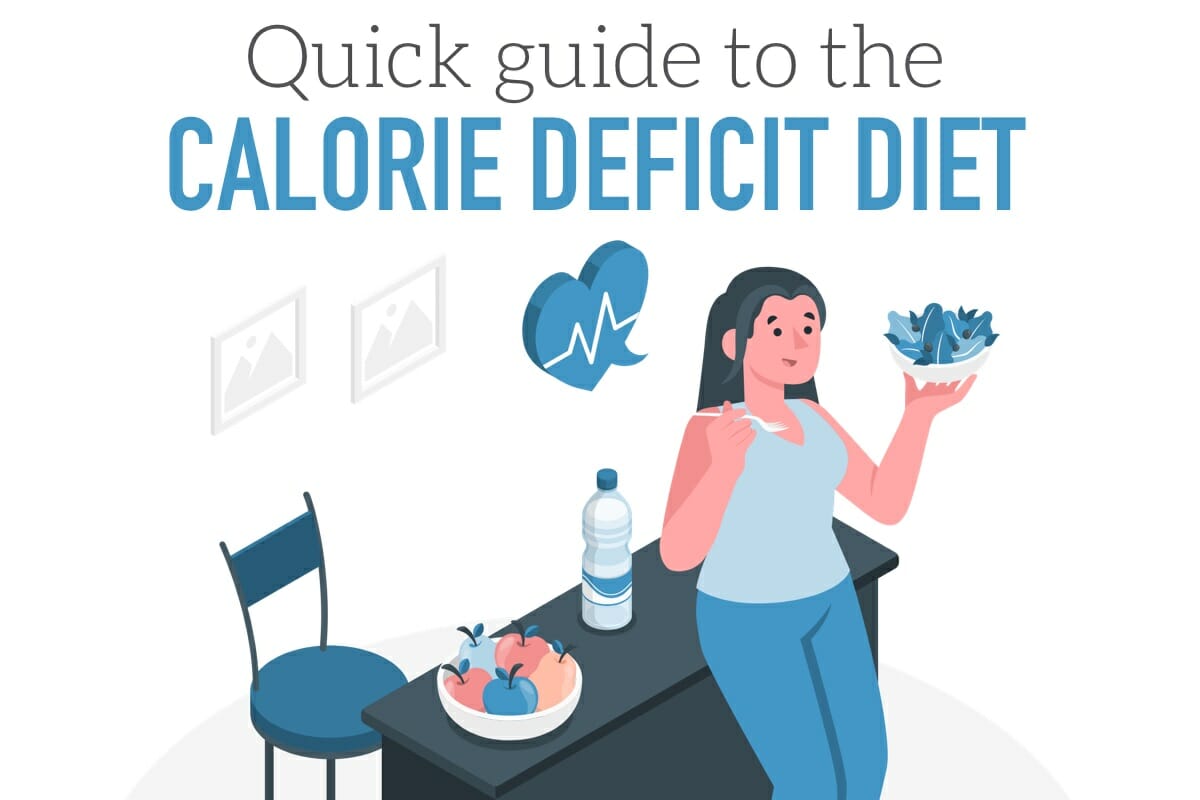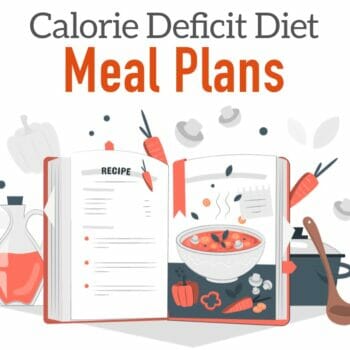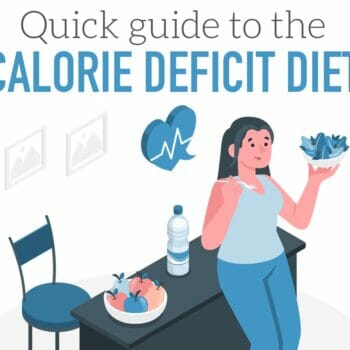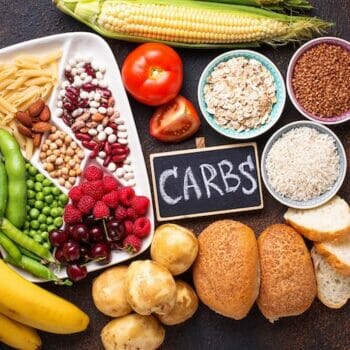Calorie Deficit Diet

What is a calorie deficit diet?
A calorie deficit diet is one in which you consume fewer calories than your body needs to maintain your current weight.
Therefore, you will force your body to start breaking down and using the stored fat it has saved for energy and metabolism.
A calorie deficit can be achieved by:
- Eating less.
- Burning calories through exercise.
The idea of a calorie deficit is not new, and is the philosophy behind almost all weight loss diets – whether Keto, Paleo, or macro counting.
How many calories should I eat a day on a deficit?
You have to know how many calories you are currently eating. You might want to use a macro tracking app to do this well.
Let’s say you eat 2,000 calories per day.
Subtract 20% to get your deficit, so 2,000 – 400 = 1,600 calories per day.
Alternately, you can use the deficit calculator and begin eating according to that amount.
Research shows that we are not very good at assessing calorie intake.
Successfully using a calorie deficit means learning to measure the caloric amounts of foods you are eating. Tracking does not need to be done forever, but only until you know how much you eat on a typical day.
The calorie deficit diet for fat loss

Basic science says that one pound of fat is equivalent to 3,500 calories. Therefore a deficit of 500 calories per day should result in a fat loss of one pound per week.
If only! The human body is remarkably adaptive. 😕
If the deficit is too low, your body will slow metabolism in an attempt to maintain equilibrium.
This is why many dieters get into a cycle of eating less and less, but not losing fat.
Determine the best deficit by:
- Calculating your BMR.
- Factoring in your activity level.
- Subtracting 20% from this amount.
Calculate your BMR using the following formula:
- For men:
66.47 + (6.24 × weight in pounds) + (12.7 × height in inches) − (6.75 × age in years). - For women:
65.51 + (4.35 weight in pounds) + (4.7 height in inches) - (4.7 * age in years)
The result is the number of calories you burn every day just by being at rest.
Next, multiply the BMR amount by your level of activity.
- Inactive (sedentary) = 1.2
- Lightly active = 1.375
- Moderately active = 1.55
- Very active = 1.725
Finally, 20% of this amount will be your deficit for fat loss.
Example
If a woman (sedentary) is 30 years old, weighs 150 pounds, and is 5’5″ tall, her BMR would be:
- BMR = 655 + (4.35 x 150) + (4.7 x 65) – (4.7 x 30)
- BMR = 1472
- Maintenance calories = 1472 * 1.2 = 1766
- Calorie deficit = 1766 * 0.20 = 353
- Daily calorie intake = 1766 – 353 = 1413
Sound complicated? Use our calorie deficit calculator.
What’s a good way to cut excess calories from your diet?
1. Cut out sugary drinks like soda and juice (easiest to hit first).
2. Avoid processed foods and snacks (easy to consume lots of calories with nutrient-poor processed food).
3. Eat more fruits and vegetables (this is more difficult).
4. Reduce portion sizes (difficult – as it is a habit change).
5. Make healthier choices when eating out (you need to know what a healthier choice is!).
6. Avoid high-calorie condiments (ranch dressing – steer clear of it).
7. Use smaller plates (tricks your mind into thinking you are eating more).
8. Avoid late-night eating (not best to energize yourself before sleeping).
9. Make sure you’re getting enough protein (protein is good at making you feel full).
10. Drink plenty of water.
The easiest way to remove excess calories from your diet is by dropping sugary drinks.
Eating more vegetables and protein are both ways of making you satisfied quicker, and therefore eating less.
Exercise and the calorie deficit diet
One method of being in a calorie deficit is by exercising long enough to burn the deficit amount.
However, it’s extremely hard to maintain a deficit from exercise alone. It’s far easier to be eating the appropriate level of calories.
Many of our clients lose weight without doing any exercise (but we always advise it, as exercise is great for mental and heart health – and maintaining muscle mass).
Use the calorie burn calculator to figure out how many calories are burned from exercise.
Can I eat whatever I want?
Yes.
Provided your daily intake is in keeping with your deficit.
However, to get the best results, you should try to reach daily targets of protein, fat, and carbohydrates.
This is called macro counting (which is based on the science of a calorie deficit).
How much of a calorie deficit is too much?
Any diet that promotes a fixed number of calories to drop is not helpful (such as eating 500 fewer calories).
In working with hundreds of clients we’ve found that a deficit of around 20% is ideal.
Anything more runs the risk of adaptive thermogenesis – metabolic slowing during caloric restriction.
How long does it take to see results in a calorie deficit?
Weigh yourself once per week.
Give yourself 8 weeks of being in deficit before deciding whether it is working.
What are the risks of cutting too many calories from your diet?
- You may lose muscle mass.
- You may not get enough vitamins and minerals.
- You may not get enough calories to support your activity level.
- You may become fatigued.
- You may have trouble concentrating.
Opting for a bigger deficit might be tempting, but the risks are not worth it.
Calorie deficit diet plan (free)
This diet plan is based on the following: 41-year-old female, weighing 150 pounds, 5 foot 4 inches tall, moderately active, extra protein, 20% calorie deficit.
It equates to around 1650 calories per day. Here’s an example of one day:
Daily Totals
- Calories: 1649
- 149 g Protein / 46.5 g Fat / 158.5 g Carbohydrate / 37.5 g Fiber
Breakfast
- Blueberry Oatmeal
- 1/4 cup (dry) steel cut oats cooked, 1 cup blueberries, 1/4 cup plain non-fat Greek yogurt.
Snack
- 12 dry roasted almonds with salt.
Lunch
- Tilapia Lettuce Wraps
- 8 oz. cooked tilapia, sautéed peppers and onion (1 cup each raw) w/ 1/2 teaspoon coconut oil, 3 large leaves of romaine lettuce, Dijon mustard.
Snack
- Banana protein smoothie
- 1 medium frozen banana (3 oz), 1.5 scoops vanilla protein powder, 1-1.5 cups water.
Dinner
- Roasted Veggie and Grilled Chicken Salad (see recipe) (2 servings)
- 1 teaspoon olive oil and 1 tablespoon balsamic vinegar as dressing
- 1 Skinny Cow ice cream sandwich
Use the calorie deficit calculator to quickly find your deficit (its free).
ReferencesReferences
- Kline, G. A., & Pedersen, S. D. (2010). Errors in patient perception of caloric deficit required for weight loss—observations from the Diet Plate Trial. Diabetes, Obesity and Metabolism, 12(5), 455-457.
- Food illustrations by Storyset
- Kline, G. A., & Pedersen, S. D. (2010). Errors in patient perception of caloric deficit required for weight loss—observations from the Diet Plate Trial. Diabetes, Obesity and Metabolism, 12(5), 455-457.
- Heinitz, S., Hollstein, T., Ando, T., Walter, M., Basolo, A., Krakoff, J., ... & Piaggi, P. (2020). Early adaptive thermogenesis is a determinant of weight loss after six weeks of caloric restriction in overweight subjects. Metabolism, 110, 154303.
- Food illustrations by Storyset

 Calorie Deficit Meal Planner
Calorie Deficit Meal Planner Calorie Deficit Diet
Calorie Deficit Diet Carbs are Not Bad, Unhealthy, and Will Not Prevent Weight Loss
Carbs are Not Bad, Unhealthy, and Will Not Prevent Weight Loss Why is Diet and Exercise Such Hard Work?
Why is Diet and Exercise Such Hard Work? Can I Eat Saturated Fat While Tracking Macros?
Can I Eat Saturated Fat While Tracking Macros?